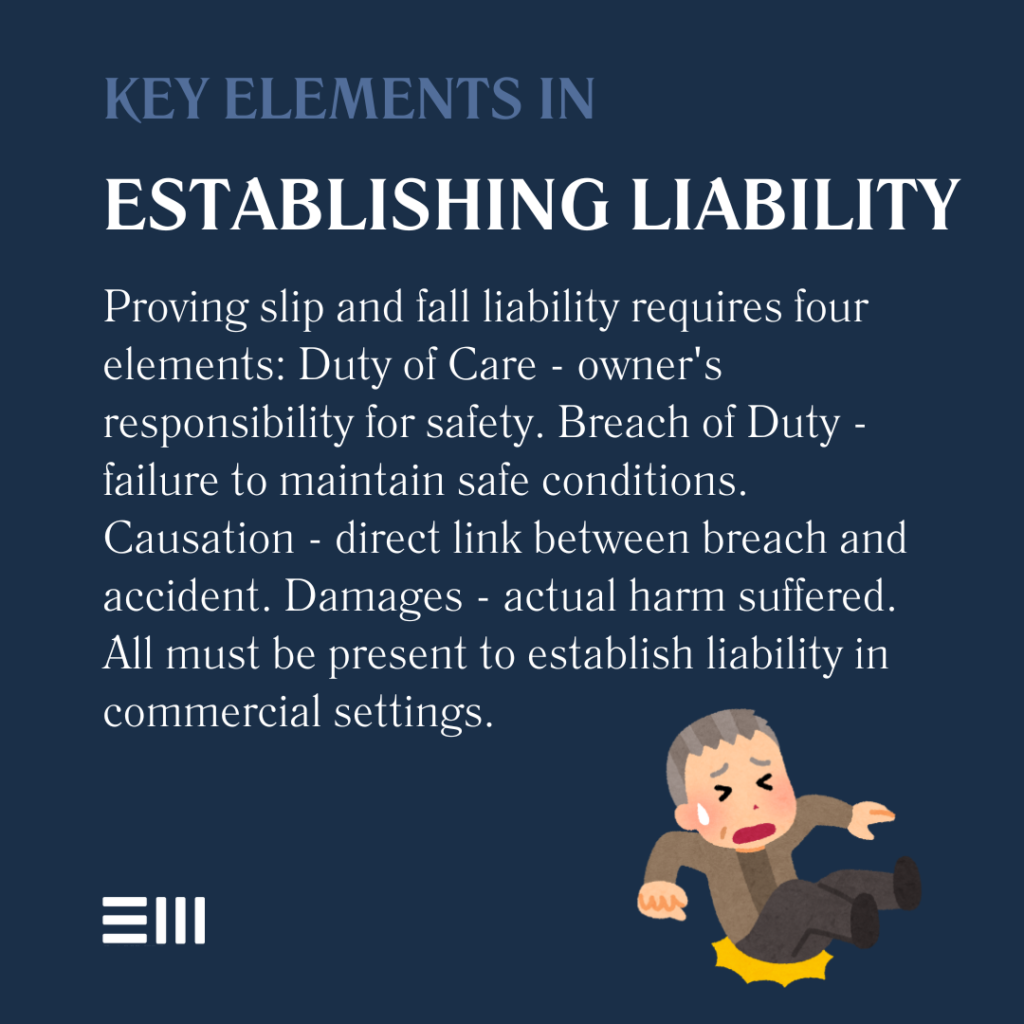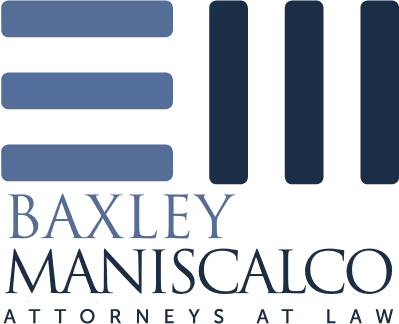
Imagine walking into your favorite store only to find yourself suddenly sprawled on the floor, surrounded by concerned onlookers.
In the blink of an eye, a routine shopping trip has turned into a potentially life-altering event. But who bears the responsibility when these incidents occur in commercial settings?
Understanding Slip and Fall Accidents in Commercial Settings
Slip and fall accidents in commercial settings encompass a wide range of incidents that occur on business premises.
These can include falls in retail stores, restaurants, office buildings, or any other property open to the public for business purposes.
The nature of these accidents can vary widely, from slipping on wet floors to tripping over uneven surfaces or poorly maintained walkways.
Key Elements in Establishing Liability
To successfully establish liability in a slip-and-fall case in a commercial setting, several key elements must be proven:
- Duty of Care: The property owner or occupier must have owed a duty of care to the injured party. In commercial settings, this duty is generally established by the injured person’s status as an invitee – someone who enters the property for business purposes beneficial to the owner.
- Breach of Duty: There must be evidence that the property owner or occupier breached their duty of care. This could involve failing to maintain the property, neglecting to repair known hazards, or failing to warn visitors of potential dangers.
- Causation: The breach of duty must be directly linked to the accident and resulting injuries. This means proving that the unsafe condition was the actual cause of the slip and fall.
- Damages: The injured party must have suffered actual damages, such as medical expenses, lost wages, or pain and suffering, as a result of the accident.
In Alabama, as in many other states, property owners and occupiers have a legal duty to maintain their premises in a reasonably safe condition for visitors. This duty forms the basis for potential liability in slip and fall cases.

Common Scenarios and Liability Implications
Understanding common scenarios can help illustrate how liability might be established in various commercial settings:
Retail Stores
In retail environments, common slip and fall hazards include:
- Spilled liquids or food items;
- Freshly mopped floors without proper warning signs; and
- Cluttered aisles or merchandise obstructing walkways.
Liability in these cases often hinges on whether the store owner or employees knew or should have known about the hazard and failed to address it promptly.
Restaurants and Bars
Restaurants and bars present unique challenges due to the frequent presence of food and beverages. Potential liability scenarios include:
- Spills not cleaned up in a timely manner;
- Grease or food debris on floors; and
- Inadequate lighting in dining areas or restrooms.
Establishments may be held liable if they fail to implement and follow reasonable cleaning and inspection protocols.
Office Buildings
In office settings, potential liability issues can arise from:
- Poorly maintained common areas;
- Hazardous parking lot conditions; and
- Malfunctioning elevators or escalators.
Building owners and property management companies may be held responsible for accidents resulting from inadequate maintenance or failure to address known safety issues.
Factors Affecting Liability Determination
Several factors can influence the determination of liability in commercial slip and fall cases:
Notice of the Hazard
One crucial factor is whether the property owner had notice of the dangerous condition. This can be:
- Actual Notice: Direct knowledge of the hazard; and
- Constructive Notice: The hazard existed long enough that the owner should have discovered it through reasonable care.
The length of time the hazard was present and the property owner’s inspection and maintenance practices are often scrutinized in determining constructive notice.
Reasonableness of the Property Owner’s Actions
Courts will consider whether the property owner took reasonable steps to maintain safety. This may include:
- Regular inspection routines;
- Prompt response to reported hazards; and
- Implementation of safety protocols and employee training.
The effectiveness and consistency of these measures can significantly impact liability determinations.
Comparative Negligence
Alabama follows a contributory negligence rule, which can significantly impact slip and fall cases. Under this rule, if the injured party is found to be even slightly at fault for the accident, they may be barred from recovering damages.
Factors that might contribute to a finding of contributory negligence include:
- Distraction (e.g., using a cell phone while walking);
- Ignoring posted warning signs; and
- Wearing inappropriate footwear for the conditions.
This strict rule makes it crucial for injury victims to demonstrate that they exercised reasonable care for their own safety.
Gathering Evidence to Establish Liability
Collecting and preserving evidence is crucial in establishing liability for a slip and fall accident.
Key pieces of evidence may include:
- Photographs or video footage of the accident scene;
- Incident reports filed with the business;
- Witness statements;
- Maintenance and inspection records; and
- Medical records documenting injuries.
Prompt action in gathering this evidence can be critical, as conditions may change quickly after an accident.
Legal Considerations in Alabama
Alabama’s legal landscape presents some unique considerations for slip and fall cases.
Statute of Limitations
In Alabama, the statute of limitations for personal injury claims, including slip and fall accidents, is generally two years from the date of the incident. This means that legal action must be initiated within this timeframe, or the right to sue may be lost.
Premises Liability Laws
Alabama law recognizes different duties owed to different types of visitors:
- Invitees (e.g., customers in a store) are owed the highest duty of care;
- Licensees (e.g., social guests) are owed a moderate duty of care; and
- Trespassers are generally owed only a duty to refrain from willful injury.
Understanding these distinctions is crucial in establishing the property owner’s legal obligations in a given case.
Government Property Considerations
Special rules apply to accidents occurring on government-owned property. These may include:
- Shorter notice periods for filing claims;
- Caps on damages; and
- Immunity protections for certain government entities.
Navigating these additional legal complexities requires specialized knowledge and experience.
Steps to Take After a Slip and Fall Accident
If you’ve been involved in a slip-and-fall accident in a commercial setting, taking the following steps can help protect your rights and strengthen a potential liability claim:
- Seek Medical Attention: Your health should be the top priority. Prompt medical care also creates a record of your injuries.
- Report the Accident: Notify the property owner or manager immediately and ensure an incident report is filed.
- Document the Scene: If possible, take photos or videos of the area where you fell, including any hazardous conditions.
- Gather Witness Information: Collect contact details from anyone who saw the accident occur.
- Preserve Evidence: Keep the clothes and shoes you were wearing at the time of the accident.
- Avoid Giving Statements: Refrain from making detailed statements to the property owner’s insurance company without legal advice.
An experienced premises liability attorney can help you understand your rights and the strength of your case.

Frequently Asked Questions
Navigating slip-and-fall liability can be complex. Here are answers to some common questions.
What Is the Time Limit for Filing a Slip and Fall Lawsuit in Alabama?
In Alabama, you generally have two years from the date of the accident to file a lawsuit. Exceptions may apply to minors or cases involving government entities. Consult an attorney promptly to ensure you meet all deadlines.
How Does Alabama’s Contributory Negligence Rule Affect Slip and Fall Cases?
Alabama’s contributory negligence rule is strict: if you’re found even 1% at fault, you may be barred from recovering damages. This makes it crucial to thoroughly document your accident and work with experienced attorneys to counter any arguments of contributory negligence.
What Types of Compensation Can Be Recovered in a Successful Slip and Fall Case?
Compensation may include:
- Medical expenses;
- Lost wages;
- Pain and suffering;
- Loss of earning capacity; and
- Property damage.
The specific amount depends on your case details, injury severity, and evidence strength.
How Do Courts Determine If a Property Owner Had “Constructive Notice” of a Hazard?
Courts consider factors like:
- How long the hazard existed;
- Visibility of the hazard;
- Property owner’s inspection practices;
- Prior similar incidents;
- Nature of the business; and
- Foreseeability of the hazard.
These help determine if a reasonable property owner should have known about and addressed the danger.
Schedule a Free Personal Injury Consultation With Baxley Maniscalco
Don’t wait. The clock is ticking on your potential claim. Contact Baxley Maniscalco now to schedule your free, no-obligation case review.
Let us put our expertise to work for you and help you navigate the complexities of establishing liability in your slip-and-fall case.
Can't find what you're looking for? Search our site below.










